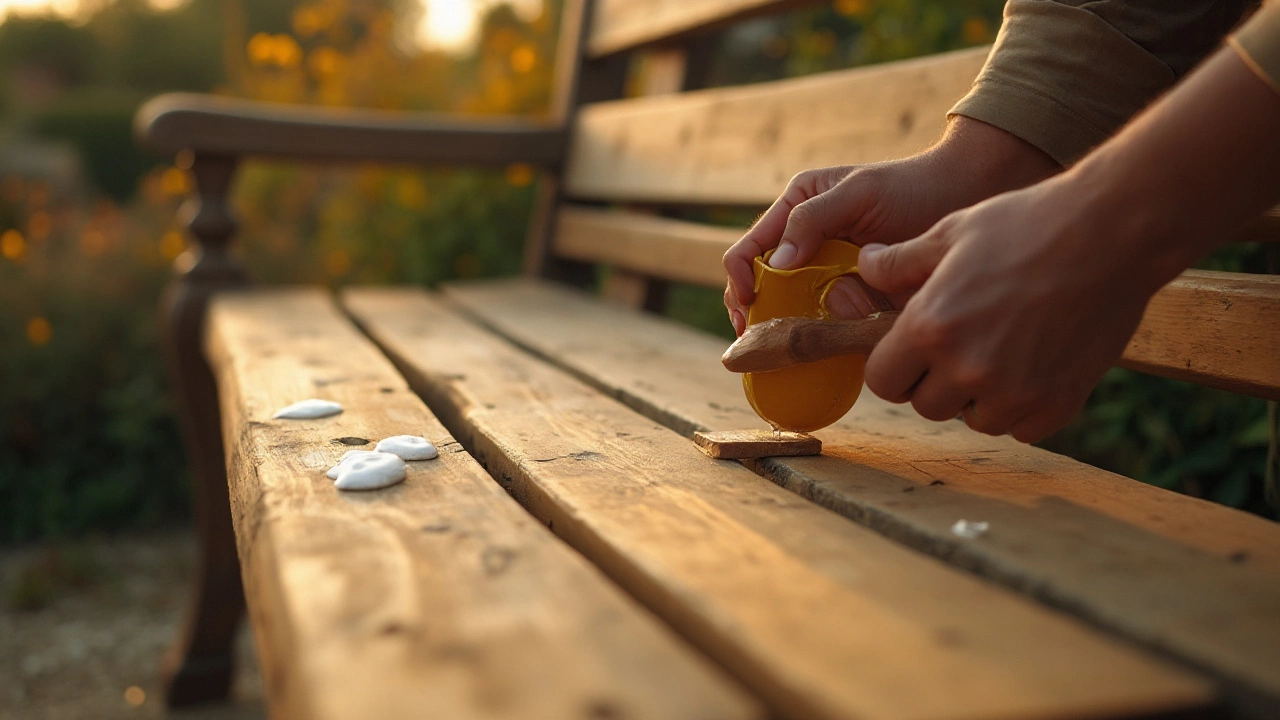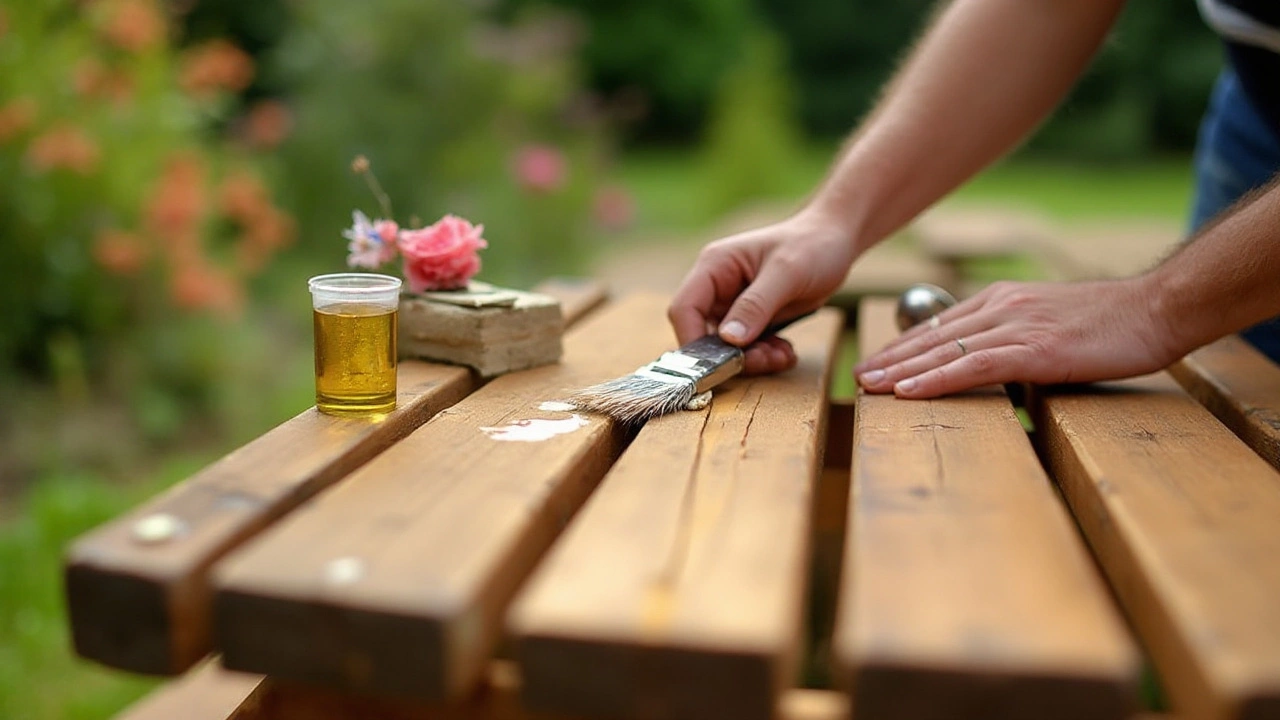When it comes to maintaining a charming outdoor space, the care of your garden furniture plays a pivotal role. Most pieces, especially those made from wood, face a variety of challenges posed by the weather. This includes moisture, sun, and even insects that can wear down their natural beauty over time. Oiling is one effective method to protect and preserve the elegance of your outdoor furniture.
In this article, we'll dive into why oiling is beneficial, explore the different types of oils available, and guide you through choosing the one that best suits your furniture. You will also find a detailed, step-by-step approach on how to correctly oil your pieces to bring out their best. Avoiding common slip-ups and understanding the process can extend the life of your furniture, making your garden a beautiful retreat year after year.
- Why Oil Your Garden Furniture?
- Types of Oils and Their Benefits
- Choosing the Right Oil for Your Furniture
- Step-by-Step Guide to Oiling Furniture
- Common Mistakes and How to Avoid Them
Why Oil Your Garden Furniture?
Oiling your garden furniture goes beyond mere aesthetics; it's about prolonging the life of your beloved outdoor pieces. Garden furniture, especially those made from wood, faces constant exposure to harsh environmental elements. Rain, sunlight, and temperature fluctuations take a toll, causing wood to crack, warp, or become discolored over time. Oiling introduces a protective layer that helps repel water and reduces the wood’s tendency to absorb moisture, which is crucial for preventing rot and decay. By regularly oiling, you not only protect but also revive the furniture’s natural glow and beauty.
While varnishing or painting can serve as alternatives, they often seal the wood, restricting its natural ability to breathe. Oiling allows the wood to maintain this natural flexibility. This method, often preferred for high-quality teak or mahogany pieces, highlights the grain, adding depth and richness to its appearance. Beyond protection, the right oil enhances the wood's natural hues, ensuring your furniture doesn’t lose its lustrous charm. It's a simple yet pivotal step in outdoor furniture maintenance.
The Science Behind Oiling
When wood is exposed to the sun, its natural oils dry out, leading to dullness and potential cracking. Applying oil replenishes these essential oils, keeping the wood supple. It's akin to moisturizing your skin. Oils penetrate the surface, fortifying the fibers and creating a barrier against external damage. This approach might sound straightforward, but the benefits are immense. Statistics indicate that properly maintained wooden furniture can last 10 to 15 years longer than neglected pieces. It's this extended lifespan that becomes particularly appealing for those who invest in premium wooden furniture.
"By applying a wood oil, you're giving your garden furniture a breath of life," remarks John Smith, a seasoned horticulturist and author of 'The Garden Furniture Handbook'. "It's a simple practice with profound benefits."
One of the most significant advantages of oiling is its eco-friendliness. Unlike synthetic sealants that might include harmful chemicals, many oils are natural or plant-based. This not only benefits the wood but also ensures that your garden stays a healthy environment, especially if you grow vegetables or have children playing around. Choosing the right oil respects your commitment to sustainability while still maintaining the elegance and durability of your outdoor living space.
Types of Oils and Their Benefits
When it comes to preserving the beauty and integrity of your garden furniture, choosing the right oil can make all the difference. There's a surprising array of choices available, each with nuanced differences in protection levels, finish, and durability. Understanding these can help you pick the best option for your outdoor pieces. The oils commonly used for outdoor wood care are often derived from natural sources, which is beneficial not only for the environment but also for achieving a charming, rustic look.
Teak oil, although named for its ideal compatibility with teak wood, serves multiple types of hardwood. One of its key attributes is its ability to penetrate deep into the wood, providing essential moisture where it's needed most. This helps prevent the dryness and cracking often induced by exposure to sun and wind.
Tung oil, originating from the seeds of the tung tree, is revered for its waterproofing properties. Upon application, it forms an elastic layer over the wood surface, sealing out moisture and dirt. It's a popular choice for those seeking a matte finish that enhances the natural grain of their furniture without adding unwanted gloss.
"Many experts agree that tung oil can provide a superior finish due to its natural resistance to water and wear," notes a recent issue of Home & Garden Magazine.
Linseed oil, derived from flax seeds, has been a staple for wood preservation for centuries. Its benefits are well-recognized, though it requires careful application, as it can take longer to dry and may require additional coatings to achieve the desired effect. Boiled linseed oil, an altered form, dries faster and may be more convenient for users concerned with time constraints.
Another option, slightly less conventional yet equally effective, is mineral oil, predominantly used in food-grade scenarios, like butcher blocks. Its simplicity lies in its ease of use and minimal impact on the wood’s color, making it a good choice especially for lighter woods that benefit from a more gentle approach.
For those looking to add a splash of color while protecting their furniture, Danish oil is a blend worth considering. It provides a blend of oil and varnish, allowing the user to impart some color along with a protective layer, offering a balance between traditional oil and modern varnishes that provide a more durable surface.
| Type of Oil | Main Benefit | Where to Use |
|---|---|---|
| Teak Oil | Deep penetration and moisture retention | Hardwood furniture |
| Tung Oil | Waterproofing and durable finish | Outdoor wooden furniture |
| Linseed Oil | Traditional preservation, rich finish | Older wooden pieces |
| Mineral Oil | Ease of use, gentle on wood | Lighter woods and food-grade surfaces |
| Danish Oil | Color addition with protection | Various woods for a colored finish |
Choosing the right oil for your garden furniture not only extends the life of your pieces but enhances their natural beauty, making your outdoor sanctuary all the more inviting. It's important to bear in mind that every type of oil requires a different level of maintenance and re-application, especially when faced with the challenges of an unpredictable climate. Balancing these factors will help you preserve your outdoor investments for years to come.

Choosing the Right Oil for Your Furniture
When selecting the right oil for your garden furniture, understanding the different options available can significantly influence the outcome. The market offers a range of oils, each with unique properties that cater to various types of wood and finishes. What you choose might depend on the specific wood type and the look you're aiming to achieve. The most commonly used oils include teak oil, linseed oil, and tung oil, each bringing distinct attributes to the table.
Teak oil, despite its name, is not sourced from teak trees, but it complements dense woods like teak and mahogany incredibly well. It's formulated to penetrate well into hardwood, enhancing the grain while providing a robust shield against moisture. Many favor teak oil for its ease of application and deep finish, lending a warm and inviting glow to your cherished pieces. Meanwhile, linseed oil, derived from flax seeds, is known for its versatility. It's often used on softwoods like pine or spruce, providing a breathable and protective layer that allows wood to maintain flexibility.
"Choosing the right finish isn't just about protection; it's about enhancing the beauty and character of your wood," says an expert from the Wood Preservation Society.
Tung oil is another excellent option; this oil cures into a hard, durable finish that weatherproofs furniture, perfect for those who live in areas with challenging climates. Its water-resistant properties make it particularly suitable for outdoor settings. While tung oil offers a stunning glossy finish, it's worth noting that it requires multiple coats for optimal protection. This oil provides a unique level of depth to the wood, revealing intricate details that might otherwise go unnoticed.
In some circumstances, blending oils can lead to satisfying results. A mix of linseed and tung oil, for instance, might give you the best of both worlds—ease of application paired with remarkable durability. Understanding your furniture's exposure to the elements and typical usage patterns can guide you toward the most effective solution. Remember, choosing the right oil is not just about enhancing your furniture's aesthetic appeal but ensuring its longevity and resilience.
Imagine a table:
| Wood Type | Recommended Oil | Attributes |
|---|---|---|
| Teak | Teak Oil | Deep penetration, moisture resistance |
| Pine | Linseed Oil | Versatile, flexible finish |
| Cherry | Tung Oil | Durable, glossy protection |
By examining the benefits of each oil, you can make an informed decision that keeps your outdoor furniture looking splendid and well-protected. Consider your personal preferences and the specific environmental conditions your furniture faces. With the right choice of oil, your garden furniture will not only look great but withstand the test of time, allowing you to enjoy sunny afternoons in style for years to come.
Step-by-Step Guide to Oiling Furniture
Transforming your garden furniture into a well-maintained and attractive outdoor feature can be a satisfying process. Proper oiling is crucial for protecting your furniture from natural elements. To begin, it's essential to ensure that the furniture is clean. Use a mild soap and water solution to gently scrub away dirt and grime. Allow the furniture to dry completely; any moisture left behind can trap mold or mildew under the oil layer.
Once the furniture is dry, lightly sand the surface using fine-grit sandpaper. This process helps remove any old or chipped finishes and opens up the pores of the wood. Sanding reduces blemishes and provides a smoother surface, enabling the oil to penetrate deeply. Be mindful of corners and intricate designs to ensure that every inch of your garden furniture is prepared. Wipe the furniture down with a clean, damp cloth to remove dust resulting from sanding.
Now, it’s time to select the right type of oil. Tung oil is popular due to its water-resistant properties, while linseed oil is loved for its deep, rich finish. Whichever oil you choose, shake the bottle well and mix thoroughly. Apply the oil using a clean lint-free cloth or brush, working along the grain rather than against it. This technique ensures the oil adheres better and provides an even finish. Let each coat absorb into the wood, which typically takes about 15-30 minutes.
Once the oil has soaked, apply another coat for a more robust finish. In some cases, you might need several coats, especially if the wood is very dry. Make sure each layer is evenly distributed and adequately absorbed. After the final coat, use a clean, dry cloth to remove excess oil and buff the surface to reveal a subtle sheen. Allow your furniture to dry thoroughly before placing it back in its outdoor environment.
“The trick with oiling garden furniture is patience. Rushing through can compromise the entire process. Let the oil do its work,” advises Sidney Harper, an acclaimed horticulturist and author.
Finally, consider applying an additional protective sealant after oiling. This can help your furniture withstand harsher weather conditions and extend the oil's effectiveness. Look for sealants designed specifically for outdoor use and are compatible with the oil you’ve chosen. By following these steps, your garden furniture will not only look more vibrant but last much longer, giving you many more seasons of enjoyment.

Common Mistakes and How to Avoid Them
Maintaining your outdoor furniture through proper oiling is vital for preserving its visual charm and longevity. However, the path can be fraught with common pitfalls that inadvertently diminish your efforts instead of enhancing your furniture. One of the most frequently seen mistakes is applying garden furniture oil without proper preparation of the surfaces. Skipping a thorough cleaning means dirt and grime get sealed alongside the oil, which can lead to a dull finish and potential long-term damage. It's crucial to clean the furniture meticulously using mild soap and water or a specialized wood cleaner to ensure the surface is spotless before you start oiling.
An often overlooked point also lies in failing to choose the right type of oil corresponding to the wood type and outdoor conditions. Not every oil suits all types of wood, and making an unguided choice can lead to an unexpected reaction with the wood, either causing discoloration or ineffective protection. Conducting a small patch test on a hidden section can be an excellent way to see the outcome without risking the entire piece. Another misstep involves over-oiling. It's tempting to think that more oil equates to better protection, but this often results in a sticky finish that attracts dust. Instead, layers should be thin and allowed to dry entirely between coatings.
There’s wisdom in patience. Most people find it easy to rush the drying process, not giving enough time between applications. This can lead to a tacky surface that's prone to damage. Allowing each layer to cure adequately ensures a smoother, more durable finish. As beautifully articulated by renowned woodworker John Collins, "Nature's patience is perennial, and so should be ours when dealing with wood care."—
John CollinsIt's important to give each phase of oiling the time it deserves instead of hastily slathering on layer after layer.
Finally, ignoring safety measures is not uncommon. The application of these oils can produce harmful fumes, so it's essential to work in a well-ventilated area or, better still, outdoors. Remember to store cloths and brushes properly as they are prone to spontaneous combustion if not handled correctly. Consider maintaining a calendar for your outdoor furniture maintenance, ensuring periodic checks and timely applications. Regular maintenance can go a long way in preventing extensive treatments, making your garden space inviting and serene.








